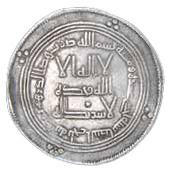 | ||
Dirham, dirhem or dirhm (درهم) is a unit of currency in several Arab states and formerly, the related unit of mass (the Ottoman dram) in the Ottoman Empire and Persian states. The name derives from the ancient Greek currency the drachma.
Contents
Currency units
Present-day dirhams include:
Unit of mass
The dirham was a unit of weight used across North Africa, the Middle East, and Persia, with varying values.
In the late Ottoman Empire (Ottoman Turkish درهم), the standard dirham was 3.207 g; 400 dirhem equal one oka.
In Egypt in 1895, it was equivalent to 47.661 troy grains (3.088 g).
There is currently a movement within the Islamic world to revive the Dirham as a unit of mass for measuring silver, although the exact value is disputed (either 3 grams or 2.975 grams).
History
The word "dirham" comes from drachma (δραχμή), the Greek coin. The Greek-speaking Byzantine Empire controlled the Levant and traded with Arabia, circulating the coin there in pre-Islamic times and afterward. It was this currency which was initially adopted as an Arab word; then near the end of the 7th century the coin became an Islamic currency bearing the name of the sovereign and a religious verse. The dirham was struck in many Mediterranean countries, including Al-Andalus (Moorish Spain) and the Byzantine Empire (miliaresion), and could be used as currency in Europe between the 10th and 12th centuries, notably in areas with Viking connections, such as Viking York and Dublin.
